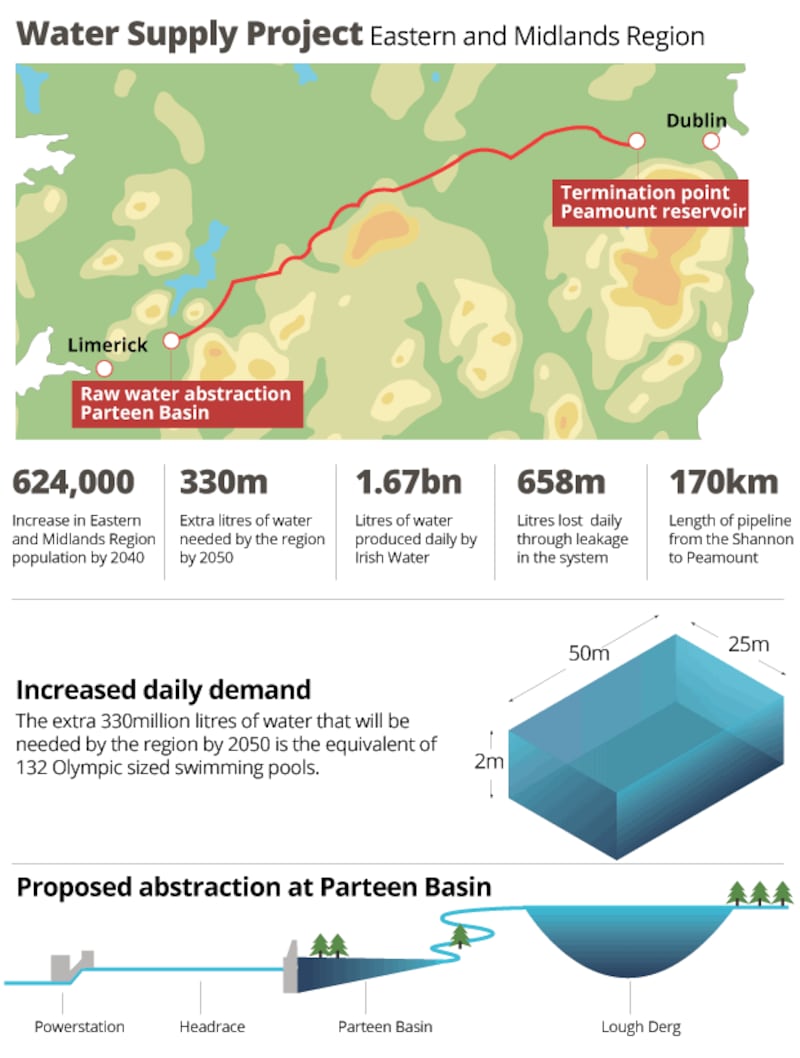Irish Water has rejected the concerns of hundreds of objectors to its plan to extract water from the river Shannon and pipe it to Dublin in a €1.3 billion project set to supply 40 per cent of Ireland's population from 2025.
Taking the water from Parteen basin on the Shannon in north Tipperary is the best way to ensure a sustainable water source for both Dublin and major towns in the midlands located close to the proposed 170km pipeline, and to provide sufficient capacity to allow for population growth and economic development up to 2050, Irish Water concludes in its latest evaluation of options published on Tuesday.
Having taken on board the views of more than 1,000 “stakeholders” in the final phase of a public consultation process, the utility confirmed it would now go ahead and seek planning permission for the project from An Bord Pleanála next year.
It said future water needs of the eastern and the midlands regions “cannot be met by fixing leaks alone”.
It has also published a detailed response to concerns raised on the route chosen, and addressed issues highlighted about the environmental impact of the project.
Landowners
Having updated data on water consumption projections and included latest census figures, it said it stands by its original analysis justifying the project, which has been subjected to sustained criticism from the River Shannon Protection Alliance and Fight the Pipe campaign, representing 500 landowners along the route.
The "Water Supply Project – Eastern and Midlands Region" would end over-dependence on the river Liffey to serve the Dublin region, and provide an additional 330 million litres of water a day which Irish Water says will be needed by the region by 2050 when its population is projected to grow to 2.1 million.
Leakage in the Greater Dublin Area network is at 36 per cent, and there are 9,000km of water pipes, 'greater than the distance between Dublin and Beijing'
The utility highlights the current lack of sufficient “headroom” to meet peak demands on supply in certain scenarios, such as a climate change event. “Failure to provide for such events will guarantee repeated supply failure, with its severe social and economic consequences,” it warns in its latest report.
In response to analysis by the financial consultant Emma Kennedy, who has advised some of the environmental groups objecting to the plan, it says future water needs of the eastern and the midland regions "cannot be met by fixing leaks alone".
It admits leakage in Dublin is “unacceptably high”, but rejects her conclusion the project would be unnecessary if Irish Water addressed its “extremely unambitious leakage-reduction targets” in the capital.

Capacity
Irish Water head of asset management Sean Laffey said existing raw water sources for the Greater Dublin Area (GDA) would be at capacity by 2025, and water saved from fixing leaks under its leakage-reduction programme would not be enough to meet future demand.
Leakage in the Greater Dublin Area network is at 36 per cent, and there are 9,000km of water pipes, “greater than the distance between Dublin and Beijing” – many of them date back to the Victorian times, and therefore vulnerable to leaks.
At present Irish Water is rolling out a comprehensive programme to address leaks which includes an initial investment of €500 million which "will save 166 million litres of water a day by 2021 – enough to supply Cork city twice over".
Over half of the water produced is used in our homes and businesses. The rest, 658 million litres of water, is lost through leaking pipes every day
“However, this cannot keep pace with growth needs,” Mr Laffey said. This is before allowing for extreme weather events such as the drought that affected the midlands last summer or the multiple bursts and water shortages following Storm Emma.
Irish Water produces 1.67 billion litres of water every day nationally, which is distributed through 63,000km of water main. Leakage is spread over the entire extent of this infrastructure, not just older pipes, it says.
“Over half of the water produced is used in our homes and businesses. The rest, 658 million litres of water, is lost through leaking pipes every day,” the report adds.
Lack of investment
Ireland’s leakage is high compared to other EU countries due to a combination of factors, including the age and condition of pipes, poor performance of certain pipe materials, soil conditions, length of the network and “lack of investment in water infrastructure over the past 150 years”.
In the Greater Dublin Water supply area (GDWSA) 207 million litres of water are lost daily. “To drive down leakage water savings must be delivered faster than the rate which new leaks occur” which adds to Dublin’s difficulties, Irish Water says. “Leakage-reduction within the GDWSA is an absolute priority. It is not a choice of either delivering leakage savings or building a new supply.”














